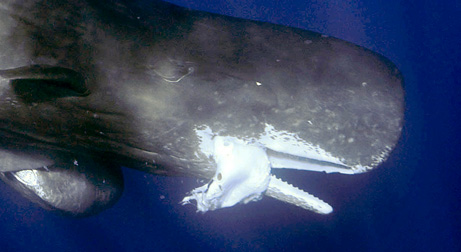Regular readers of my blog may remember this post on Aurora the octopus. To refresh your memory:
A month later, Aurora laid tens of thousands of eggs. Her sense of mothering was strong, despite the fact that her eggs didn’t appear to develop and aquarists eventually believed they were sterile.
Day in and day out, she sucked in water through her mantle and sent waves of cleansing water over the eggs. She defended them against hungry sea cucumbers and starfish.
I have checking from time to time to see if I can find more information on Aurora and I finally have some, slightly old (it’s dated 7/3/05) news concerning Aurora and her offspring:
Aurora’s eggs appear to have mostly hatched out with a few clusters still containing embryos still to emerge. Aurora has become more active again, often seen stretching out across the tank window. The numbers of emergent paralarvae vary daily but the end of the hatch appears in sight.
Paralarva count on May 30 – 178 babies swimming and feeding in their rearing tank and they appear to have hearty appetites.
Most of these little swimmers were transferred from a separate group of Aurora’s eggs housed in a holding tank. However, Aurora’s own egg brood also continues to emerge in view of SeaLife Center visitors. This photo shows her Monday afternoon after a short bit of activity twirling her arms and casting off old sucker disk skin. She momentarily opened up her arms widely enough to allow a better examination of a few of her many remaining unhatched eggs.
Currently, the paralarvae are eating suspended daphnia and live brine shrimp nauplii larvae periodically pulsed into the rearing tank. In addition, many of the baby octopuses are now also able to rip pieces off of small shrimp suspended in the rearing tank for a few hours. This latter food item is easy to add and remove before it becomes a mess to clean up. We are still testing and evaluating various food types recognizing that probably no single food item may be a universal diet. The oncoming challenge will be anticipating and matching different foods to the growing animals’ changing food preferences.
As for the developing paralarvae held elsewhere in the SeaLife Center, we are working with a group that now contains 90+ individuals in a rearing system designed for feeding and long-term rearing. Our aquarists report there are some that have grown larger noticeably feeding on a diet of mashed krill, Mysis shrimp and clam.
Additionally many more of Aurora’s brood have been added to an outdoor tank with natural plankton production during the long Alaska summer days to more or less fend for themselves. This group is less accessible for frequent evaluation until later in the year but may surprise us with survivors that grow and settle out of the water column to live on the tank bottom.
So apparently, as of July third Aurora was still alive! Which is good as in my last post I mentioned there was some indication that she might die. That’s one tough, determined octopus!

According to MSNBC this is an actual picture of Aurora.
And here is a series of pictures showing the development of the baby octopi.





Are they not the cutest things you have ever seen? Well, okay Aye-Ayes are cuter but these run a close second!
Filed under: Invertebrates, Octopi | Tagged: Octopus | 6 Comments »










